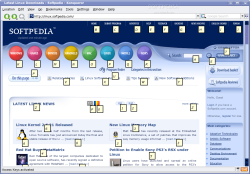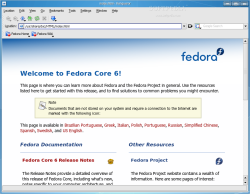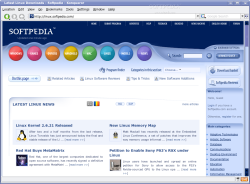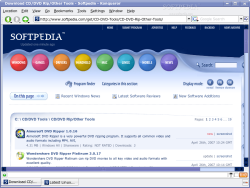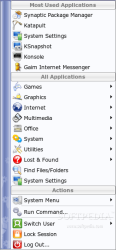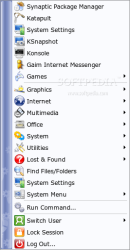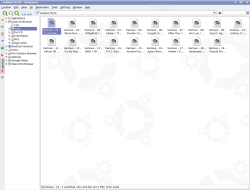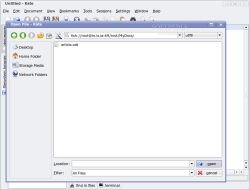The K Desktop Environment is a free project which aims to be a powerful system for an easy-to-use desktop environment. The project well suits both regular and advanced users due to its wide range of functions and applications which can be customized through GUIs. There are, however, some of them for which no GUI exists, providing users with some features they may not need or want and, at the same time, stopping them from using some features they might need.
Konqueror Access Keys
While browsing the web, every time you press the Ctrl key, small squares containing a different letter appear in the website. This feature is useful when you want to follow a link on the website, but for different reasons, you can't use your mouse to click on it. But most of the times, this is quite annoying; for instance, when using your keyboard to copy and paste text so many people would rather disable it completely. To disable it, open a terminal and type this command as the user you want to disable access keys for:
Have Location and Main Toolbar on the same row in Konqueror
By default in some distributions, Konqueror is configured in a bit strange way. Its Main toolbar holds the back, forward, refresh etc buttons, while the Location toolbar holds the address bar, search bar and a few other buttons. And it gets even worse when the bookmarks toolbar is also activated by default. Not very aesthetic. To disable the bookmarks toolbar, un-select it from Settings / Toolbars / Bookmark Toolbar. Moreover, to have the Location and Main toolbar on the same line, open the file /home/YOUR_USER/.kde/share/apps/konqueror/konqueror.rc , search for the following line:
Hide 'New Tab' and 'Close Tab' buttons from Konqueror's Tab bar
By default, there's a button for opening a new tab to the left and a button for closing the active tab to the right. You may hide both or only one button. If you choose to hide both, remember the default key combinations for these actions: Ctrl + T for opening a new tab and Ctrl + W for closing the active tab. To hide the buttons, type these commands in a terminal:
kwriteconfig --file konquerorrc --group FMSettings --key CloseTabButton --type bool false
kwriteconfig --file konquerorrc --group General --key MinimumTabLength 3
The Konqueror preferences dialog allows you to choose either to display the website's icon or a close button, in the same (left) part. You can't have them both unless you type these commands in a terminal:
kwriteconfig --file konquerorrc --group FMSettings --key HoverCloseButton --type bool true
kwriteconfig --file kio_httprc --key SendReferrer --type bool false
Konqueror tabs at bottom
If you prefer Konqueror to have tabs at the bottom, run this command in a terminal:
Don't show category titles in K Menu
By default, the K Menu displays category titles for each section: 'Most Used Applications', 'All Applications' and 'Actions'. I always thought they are 'too obvious' and totally useless so I was happy to find out that I can remove them by typing this command in a terminal:
KDE I/O SLAVES
Also known as KIO, this built-in feature provides easy access to network files just as if they were stored locally. To use these protocol handlers include http and ftp so the easiest way to use them is through Konqueror. You can see all the available protocol handlers in KInfoCenter, under Protocols. I'll just go through the most important ones.
audiocd:/
Once you insert an audio CD in your CDROM drive and type this handler in the konqueror's address bar, you'll notice that KDE is able to transparently encode your audio CD into various digital formats. Basically, you can rip your CD without any additional software. Simply copy the directory you want (Ogg, MP3, FLAC etc) and paste it on the drive.
bluetooth:/ - Allows you to browse through files stored on bluetooth-enabled devices.
fonts:/ - Enables you to manage the fonts installed on your system. You can delete or add new fonts here.
print:/ - Provides full support for printing under Linux. Here you'll see the printers available on your network, their jobs and more.
settings:/ - Provides a mechanism to configure your KDE desktop.
man:/ and info:/ - Offers a clean interface to the system manual and GNU info pages.
locate:/file-name - A very fast search method. It just requires that command updatedb is ran once in a while.
tar:/path/to/file.tar and zip:/path/to/file.zip - Allows you to browse tar or zip archives without unpacking them. You can even edit its contents as if it were unpackaged.
Even more interesting are the protocol handlers for network access, besides the http: and ftp:
fish://user@host - Access files on a remote machine through SSH. smb://host - Access a Samba share or files shared on Windows machines. sftp://host - SSH encrypted FTP browser. imap://host - Access your IMAP mail account. ldap://host - Browse a LDAP directory. nntp://host - Access a Usenet news server.
Being able to do these things from Konqueror isn't quite impressive, as for each protocol there are complex programs with a lot of useful features. The real power of these protocols is noticed when they are used within other applications. For instance, if you want to edit your web page, simply open a word processor or a html editor, go to File > Open, type the location address like this (as long as you also have SSH access to the machine hosting your web site): fish://host. Then, open the file, modify it and save it just like you would save it locally.
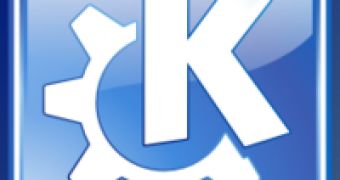
 14 DAY TRIAL //
14 DAY TRIAL // 